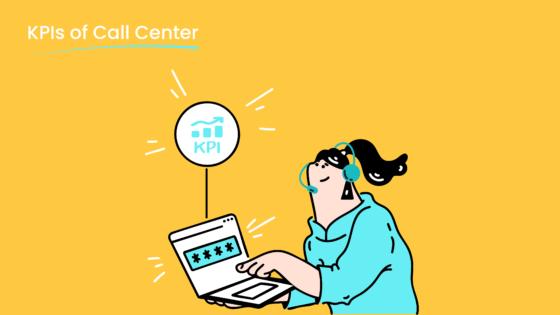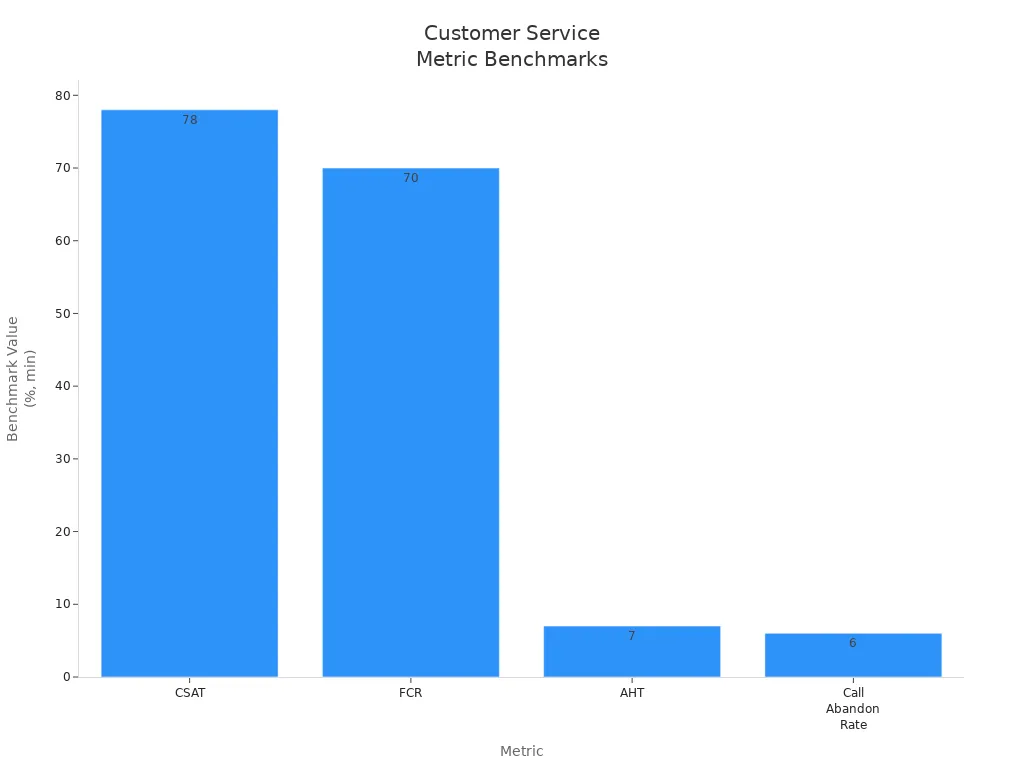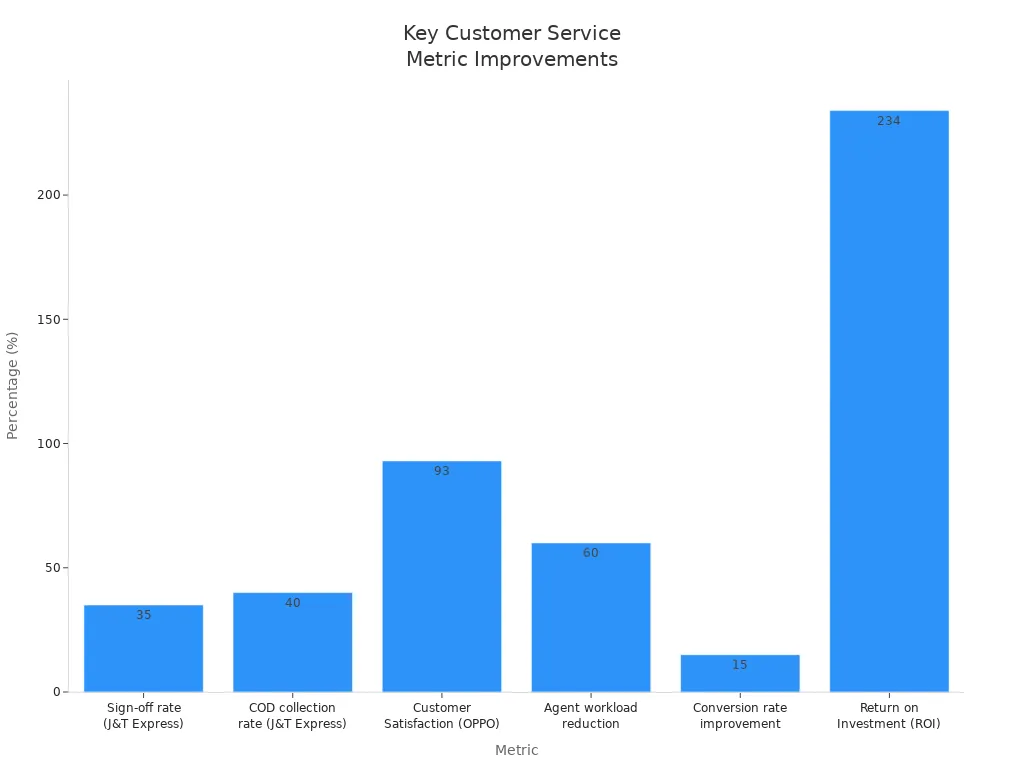Unlock Customer Service Excellence with Effective KPI Metrics

You can unlock customer service excellence by focusing on the right KPIs. Tracking common kpi metrics for customer service, such as satisfaction scores or first-contact resolution, gives you clear insight into your team's impact. For example, even small KPI improvements can boost loyalty and drive repeat business. Sobot AI and Sobot call center solutions empower you to act on these metrics. With Sobot's commitment to innovation and customer-centricity, you gain tools that turn data into real results.
Customer Service KPI Basics

What Are Customer Service KPIs
Customer service KPIs are measurable values that help you track how well your support team meets its goals. These KPIs give you a clear picture of your team's performance and the quality of the customer experience you deliver. You can use customer service kpis to measure agent efficiency, customer satisfaction, and the overall health of your support operations.
You will find that leading organizations group customer service kpis into three main categories:
- Performance KPIs: These focus on how efficiently your agents work. For example, Average Handle Time (AHT) shows how long it takes to resolve a customer issue.
- Experience KPIs: These measure how customers feel about your service. Customer Satisfaction Score (CSAT) and Net Promoter Score (NPS) are common examples.
- Operational KPIs: These track workflow and resource management, such as ticket backlog or agent utilization rate.
Tip: Measuring several customer service kpis together gives you a complete view of your support team's strengths and areas for improvement.
Here is a table of common customer service kpis and their benchmarks:
| KPI Category | Common KPIs | Description / Benchmark Highlights |
|---|---|---|
| Agent Performance | Average Handle Time (AHT), Adherence, First Contact Resolution (FCR), CSAT per agent, Repeat Contact Rate, Utilization Rate | AHT measures average time per inquiry; FCR % resolved first time (benchmark >80%); Adherence target 90-95%; Utilization 85-90% |
| Customer Satisfaction | Customer Satisfaction (CSAT) Score, Net Promoter Score (NPS), Customer Effort Score (CES), Repeat Contact Rate, Negative Social Mentions, Customer Lifetime Value | CSAT aims for 85-90%; NPS >50 excellent; CES benchmark >4; Repeat contact rate target under 10% |
| Issue Resolution | First Contact Resolution Rate, Average Resolution Time, Backlog/Pending Tickets, Reopened Ticket Rate, Issue Escalation Rate, Knowledge Base Usage | FCR high is better; Resolution time measures speed; Reopened tickets <10%; Escalation rate low indicates good first-tier resolution |
You can use Sobot’s omnichannel platform to track these customer service kpis in real time, making it easier to spot trends and take action.
Why Customer Service Metrics Matter
Customer service metrics play a key role in customer experience management. When you track customer service kpis, you gain insights that help you improve both your team’s performance and your customers’ satisfaction. For example, measuring first response time helps you reduce customer frustration and prevent repeat contacts for the same issue. This leads to higher customer retention and loyalty.
You can use customer service metrics to:
- Identify problems early and fix them before they affect the customer experience.
- Set clear goals for your team and measure progress over time.
- Make better decisions about staffing, training, and technology investments.
- Benchmark your performance against industry standards.
Sobot’s solutions, such as the Voice/Call Center and unified workspace, allow you to automate data collection and monitor customer service kpis across all channels. This helps you respond faster and deliver a seamless customer experience. Companies that use dashboards and analytics tools see steady improvements in their customer service kpi results and overall customer experience.
Note: Tracking customer service kpis helps you focus on what matters most to your customers and your business. Avoid relying on a single metric. Instead, use a balanced set of KPIs to guide your support strategy.
Aligning KPIs with Business Goals
Setting Relevant Customer Service KPIs
You need to set customer service kpis that match your company’s vision and mission. Start by defining your business goals, such as increasing customer retention or driving revenue growth. When you select customer service kpi targets, make sure they measure progress toward these goals. For example, use Net Promoter Score (NPS) to track customer loyalty or monitor customer retention rate to see how well you keep customers coming back.
Follow these steps to set relevant customer service kpis:
- Align each customer service kpi with both your company and customer goals.
- Understand why customers engage with your business and what sets you apart.
- Define clear, measurable targets for each kpi, such as aiming for a customer retention rate above 85%.
- Combine leading indicators (like first response time) with lagging indicators (such as CSAT) for a full view of performance.
- Involve your support agents in the process to secure their buy-in and commitment.
- Tailor your customer service kpis to your business model, considering unique touchpoints and service expectations.
For example, a retail company may focus on CSAT and first contact resolution, while a financial services provider may prioritize compliance and customer retention rate. Sobot’s omnichannel platform helps you track these customer service kpis in real time, so you can adjust quickly and stay aligned with your business goals.
Tip: Regularly review and update your customer service kpis to keep pace with changing business needs and market trends.
Mapping KPIs to Support Strategies
You can improve customer experience outcomes by mapping customer service kpis to your support strategies. When you align your customer service kpis with business goals, you ensure that every action your team takes supports your company’s success.
- Use customer service kpis to identify key objectives, such as reducing churn or increasing customer loyalty.
- Select metrics like customer satisfaction, first response time, and resolution time that reflect these objectives.
- Set SMART goals for each kpi to give your team clear targets.
- Optimize resource allocation and streamline processes based on kpi insights.
- Invest in agent training and technology, such as Sobot’s Voice/Call Center, to enhance performance and speed up issue resolution.
- Implement proactive support strategies by analyzing kpi data to prevent problems before they affect customers.
For instance, companies like Hilton Hotels have used customer service kpis such as NPS and customer lifetime value to boost guest satisfaction and revenue. Technology plays a key role here. With Sobot’s unified workspace and analytics, you can monitor customer kpis, make informed decisions, and drive continuous improvement.
Note: Proactive support strategies based on real-time kpi analysis help you deliver better service, increase customer retention, and build lasting customer loyalty.
Common KPI Metrics for Customer Service
Key Customer Service Metrics
You need to track the right metrics to improve customer service performance. The most common kpi metrics for customer service include customer satisfaction, first contact resolution, first response time, average handle time, and customer effort score. Each metric gives you a different view of how well your team supports customers.
Customer satisfaction shows how happy your customers feel after an interaction. The customer satisfaction score (CSAT) is a quick way to measure this. Industry benchmarks show that a CSAT above 85% is world-class. First contact resolution tells you how often your team solves issues on the first try. A first contact resolution rate above 80% means your team delivers excellent service. First response time measures how quickly your team replies to customers. Fast first response time leads to higher customer satisfaction and better customer retention.
Average handle time tracks how long it takes to resolve a customer issue. The industry average handle time is about 7 minutes, but you should balance speed with quality. Customer effort score helps you see how easy it is for customers to get help. Low effort means a better customer experience.
Here is a table of industry benchmarks for advanced customer service metrics:
| Metric | Industry Benchmark Average | Good Benchmark Range | World-Class Benchmark | Notes |
|---|---|---|---|---|
| Customer Satisfaction (CSAT) | 78% (Top Box Score) | 75% - 84% | 85% or higher | Only 5% of call centers achieve world-class CSAT. Surveys conducted post-call within 1 day. |
| First Call Resolution (FCR) | 70% | 70% - 79% | 80% or higher | Varies by call type, industry, and touchpoint. Below 70% needs improvement. |
| Average Handle Time (AHT) | 7 minutes (average) | Context-dependent | N/A | Lower AHT preferred if FCR is maintained; varies by call type and industry. |
| Call Abandon Rate | 6% | <5% considered good | N/A | Rates over 5% often too high; great CSAT centers have ~3% or less. |

Measuring and Improving Customer Service KPIs
You can measure common kpi metrics for customer service using surveys, call monitoring, and analytics tools. Sobot’s Voice/Call Center gives you real-time tracking for customer service kpis like first response time, first contact resolution, and average handle time. You can use dashboards to spot trends and act fast.
To improve customer service performance, design CSAT surveys for specific interactions. Use predictive analytics to find customers at risk of leaving. Balance automation and human support by tracking self-service rates and first contact resolution. Regularly review your customer feedback and compare your results to industry benchmarks. Sobot’s unified workspace and advanced customer service metrics help you make data-driven decisions and boost customer satisfaction.
Tip: Use gap analysis to compare your current customer service kpi results with your goals. Adjust your strategy based on live data to drive continuous improvement in customer experience.
Best Practices for Achieving Customer Service KPIs
Achieving strong results with customer service kpis requires more than just tracking numbers. You need a clear plan, the right tools, and a team that understands what success looks like. Here are the best practices for achieving customer service kpis that will help you drive performance improvement and deliver excellent customer experiences.
Make KPIs SMART
You should always make your customer service kpis SMART: Specific, Measurable, Achievable, Relevant, and Time-bound. This approach turns vague goals into clear targets that everyone can understand and work toward.
- Specific: Define exactly what you want to achieve. For example, instead of saying "improve customer satisfaction," set a goal like "increase CSAT from 85% to 90% by year-end."
- Measurable: Use numbers or data to track progress. You might measure first response time in minutes or track the percentage of tickets resolved on the first contact.
- Achievable: Set goals that your team can realistically reach based on past data and available resources. Unrealistic targets can lower morale and reduce motivation.
- Relevant: Align each KPI with your business priorities. If your main goal is to boost loyalty, focus on metrics like Net Promoter Score (NPS) or customer retention rate.
- Time-bound: Give each goal a deadline. This creates urgency and helps you evaluate progress at regular intervals.
Making customer service kpis SMART brings clarity and accountability. You can track progress, adjust strategies, and celebrate wins with your team.
Companies that use SMART KPIs see better results. For example, setting a goal to raise CSAT by 5% in six months gives your team a clear target and a timeline. Regular evaluation lets you adjust your approach if needed, keeping your goals realistic and aligned with your business strategy.
Team Involvement and Training
Your team plays a critical role in achieving customer service kpis. When you involve agents in goal-setting and provide ongoing training, you build a culture of ownership and continuous improvement.
- Training programs help agents develop the skills they need to deliver great service. Well-trained teams often see higher customer satisfaction scores and better first contact resolution rates.
- Regular feedback sessions and coaching boost morale and help agents learn from real interactions. You can use metrics like ticket reopen rates to spot training needs and address them quickly.
- Managers should provide resources and support, making sure everyone understands the importance of each KPI. When agents know how their work impacts business goals, they feel more engaged and motivated.
Tip: Use 360-degree feedback to gather insights from both customers and team members. This helps you identify strengths and areas for improvement.
Research shows that companies investing in agent training see lower turnover and higher service quality. For example, after implementing targeted training, many organizations report a noticeable increase in CSAT and NPS scores. Sobot’s unified workspace makes it easy to monitor agent performance, identify skill gaps, and deliver personalized coaching.
Continuous Improvement
Continuous improvement is the backbone of sustained success with customer service kpis. You need to review your metrics regularly, act on feedback, and adapt your strategies as your business grows.
- Track key metrics like CSAT, NPS, and customer retention rate to spot trends and measure progress.
- Use real-time dashboards to monitor performance and respond quickly to issues. Sobot’s omnichannel solution provides instant visibility into every customer interaction, helping you identify friction points and prioritize improvements.
- Collect feedback from both customers and agents. Analyze open-ended responses to understand the story behind the numbers.
- Segment your data by channel, issue type, or customer segment. This helps you tailor your strategies and address specific challenges.
- Set up automated alerts for critical KPIs. This allows you to take immediate action when performance drops below your target.
Proactive support strategies—like mapping the customer journey and using predictive analytics—help you prevent problems before they affect customer satisfaction.
Companies that commit to continuous improvement often outperform their peers. For example, Salesforce maintains a 93% SLA compliance rate by regularly reviewing and adjusting their targets. American Express improved retention by 10% after launching service recovery programs based on customer feedback.
Leveraging Technology and Sobot Solutions
Technology plays a vital role in the best practices for achieving customer service kpis. Omnichannel and automation solutions streamline workflows, reduce manual effort, and provide the data you need for informed decision-making.
- Sobot’s omnichannel platform unifies all customer interactions in one place. This makes it easier to track KPIs across channels and maintain conversation context.
- AI-powered chatbots and voice assistants handle routine queries, freeing agents to focus on complex issues. This improves response times and boosts customer satisfaction.
- Real-time analytics and dashboards let you monitor performance, set up automated alerts, and quickly identify areas for improvement.
- Automation tools reduce agent workload and improve consistency. For example, Sobot’s AI-driven solutions can resolve common questions instantly, increasing first contact resolution rates and lowering average handle time.
Proactive support strategies powered by automation help you deliver seamless, personalized experiences that drive loyalty and repeat business.
Omnichannel solutions also make it easier to segment and analyze data. You can track KPIs independently for each channel, ensuring your strategies reflect the unique needs of your customers. Sobot’s platform supports integration with CRM and other business systems, giving you a holistic view of your customer service performance.
Key Steps for Ongoing Success:
- Collect and consolidate data from all customer touchpoints.
- Regularly review and recalibrate your KPIs to match evolving business goals.
- Train your team on new tools and best practices.
- Use dashboards and automated alerts to stay ahead of issues.
- Foster a culture of feedback and continuous learning.
By following these best practices for achieving customer service kpis, you set your team up for long-term success. You can deliver better customer experiences, drive performance improvement, and build a loyal customer base.
Leveraging Technology for Customer Service KPIs
Tools for KPI Tracking
Technology transforms the kpi tracking process by automating data collection and analysis. You no longer need to rely on manual spreadsheets or delayed reports. Modern platforms gather data from every customer interaction and present it in a kpi dashboard. This real-time visibility helps you spot trends, address issues, and drive continuous improvement.
Here is a comparison of leading tools for kpi tracking:
| Tool Category | Leading Tools | Key Features and Use Case |
|---|---|---|
| Helpdesk Platforms | Zendesk, Intercom, Freshdesk, HubSpot | Automatically log tickets, track requests per month, first response time, resolution time, CSAT, FCR, backlog |
| Dashboard Tools | Geckoboard, Looker Studio, Power BI, Tableau | Visualize and report KPI trends with clear, actionable dashboards |
| Small Teams Solutions | Google Sheets with scheduled exports | Simple, cost-effective tracking for teams without dedicated platforms |
You should set benchmarks, segment data by channel, and share insights through automatic reports or a kpi dashboard. This approach ensures your kpi tracking supports ongoing improvement. Automated tools also reduce errors and free up your time for strategic decisions.
Note: Customer service analytics platforms use AI and robotic process automation to deliver instant insights. You can quickly identify performance gaps and respond to customer needs.
Sobot Voice/Call Center Integration

Sobot Voice/Call Center takes kpi tracking to the next level. You get a unified workspace that connects calls, customer data, and real-time kpi dashboards. The platform supports 99.99% uptime, so your kpi tracking never stops. Integration with CRM systems lets you track metrics like NPS, average handle time, and first-contact resolution without extra effort.
| Feature/Capability | Description/Impact |
|---|---|
| Uptime | 99.99% uptime ensures stable and reliable call center operations, supporting continuous KPI tracking. |
| CRM Integration | Seamless integration links calls with customer data for accurate KPI tracking. |
| Call Monitoring | Real-time alerts on call duration, keywords, and customer actions enable timely intervention. |
| Statistical Reporting | Hundreds of indicators and metrics for detailed performance evaluation. |
| AI Features | Voicebot and AI Copilot analyze speech and generate post-call summaries, enhancing customer service analytics. |
| Agent Workspace and Routing | Unified workspace and smart routing improve efficiency and customer satisfaction. |
| Real-time Dashboards | Managers monitor operations remotely, making proactive KPI management possible. |
With Sobot, you can monitor first contact resolution, average time in queue, and abandon rate in real time. The kpi dashboard gives you actionable insights to optimize staffing and improve agent productivity. Real-time kpi tracking helps you make quick adjustments and deliver better customer experiences.
Tip: Use Sobot’s customer service analytics to drill down into specific channels or agents. This helps you align resources and boost your service quality.
Real-World Success: Sobot Customer Stories

OPPO’s KPI Transformation
You can see the impact of effective KPI management in OPPO’s journey with Sobot. OPPO, a global leader in smart devices, faced high volumes of customer inquiries, especially during peak shopping seasons. By adopting Sobot’s AI-powered chatbot and ticketing system, OPPO transformed its customer service operations. The chatbot handled repetitive questions, freeing agents to focus on complex issues. Sobot’s unified platform also helped OPPO integrate customer channels and business systems, making data more accessible.
Here is a snapshot of OPPO’s measurable improvements after implementing Sobot’s solutions:
| Customer Service KPI | Improvement Achieved |
|---|---|
| Resolution Rate | 83% |
| Positive Feedback Score | 94% |
| Repurchase Rate Increase | 57% |
These results show how you can achieve higher efficiency and better outcomes by leveraging the right technology. OPPO’s positive feedback score reached 94%, reflecting a significant boost in customer satisfaction. The 57% increase in repurchase rate highlights the business value of improved service quality.
Lessons from Sobot Implementations
You can apply several key lessons from OPPO and other Sobot customers to your own business:
- Use KPIs to identify where you need to improve and track your progress with real data.
- Monitor and analyze your KPIs regularly to spot trends and address issues early.
- Adapt your KPIs and strategies as your customers’ needs and your business goals change.
- Look at how different KPIs connect to get a complete picture of your customer experience.
- Review your KPIs often to fix problems before they grow, which helps you deliver better service.
- Remember, data-driven improvements in KPIs can lead to more loyal customers and business growth.
Tip: Align your KPIs with your company’s goals and foster a culture that values continuous improvement. Companies that do this are more likely to achieve sustainable growth and higher customer satisfaction.
Sobot’s omnichannel and AI-driven solutions make it easier for you to track, analyze, and act on your KPIs in real time. When you use these tools, you empower your team to deliver excellent service and drive measurable business results.
Effective customer service KPI implementation drives higher loyalty, better retention, and stronger team performance. You gain real-time insights, boost agent motivation, and align your goals with business growth. Sobot’s AI-powered solutions help you track key metrics, automate tasks, and deliver fast, personalized support. Companies like OPPO and Agilent have seen customer satisfaction soar and costs drop.

Start measuring, engaging your team, and using technology like Sobot to unlock customer service excellence today.
FAQ
What are the most important customer service KPIs to track?
You should focus on customer satisfaction (CSAT), Net Promoter Score (NPS), first contact resolution, and average handle time. These customer service kpis show how well your team meets customer needs and helps you spot areas for improvement.
How often should you review customer service KPIs?
You should review customer service kpis weekly or monthly. Regular reviews help you catch trends early and make quick changes. Sobot’s real-time dashboards make it easy to monitor these metrics and keep your team on track.
How can Sobot help improve customer service KPIs?
Sobot provides an omnichannel platform and AI-powered tools. You can track customer service kpis in real time, automate routine tasks, and analyze performance. Many companies see higher CSAT and faster response times after using Sobot’s solutions.
Why do customer service KPIs matter for business growth?
Customer service kpis help you measure team performance and customer happiness. High scores in these metrics often lead to more loyal customers and repeat business. For example, companies with high NPS grow faster than their competitors (Bain & Company).
Can you set different customer service KPIs for each channel?
Yes, you can set unique customer service kpis for phone, chat, email, or social media. Sobot’s unified workspace lets you track and compare these metrics across all channels, so you can tailor your support strategy for each customer touchpoint.
See Also
Effective Strategies For Managing Call Center Quality
Ways To Improve Call Center Results Through Monitoring
Leading Customer Support Software Solutions For 2024
